Beets
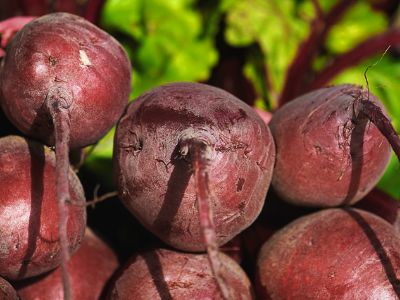
Preparation: Step-by-Step
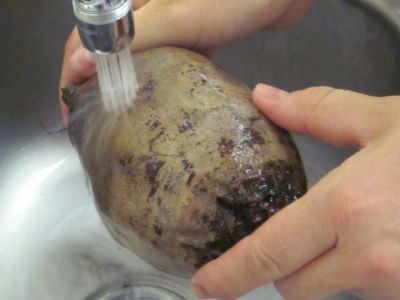
Wash hands. Remove leaves and cut stem down, leaving
approximately one inch to prevent bleeding and flavor
loss. Thoroughly scrub beets to remove dirt or sand.
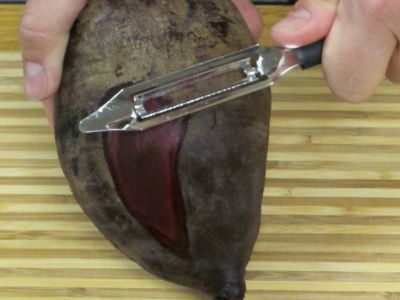
When cooked whole, leave root end attached to prevent
bleeding. Trim and peel with a vegetable peeler. It is not
necessary to peel small, young beets with tender skins,
but larger beets should be peeled before use..
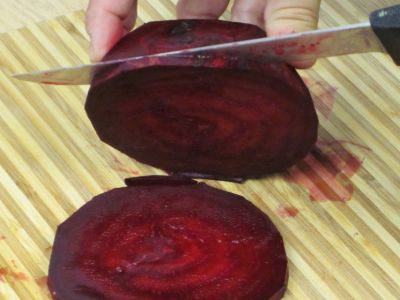
Sliced beets can add flavor and color to any dish.
Take care when handling beets. They can leave red
stains on fabric, cutting boards, and hands.
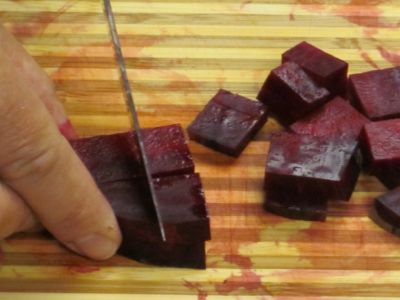
To serve: slice, dice or quarter large beets. Small beets may
be left whole. If mixing with other ingredients, add just
prior to serving to prevent color bleeding onto other foods.
Grow.
- Plant from seed in full sun as soon as soil can be worked. Plant seeds ¾-inch deep
and one inch apart in rows 18 inches apart. Thin to 3-4 inch spacing. Consider using
a floating row cover for insect control early in the season. Water consistently with
1-2 inches of water per week.
For more growing information, look for the MSU Extension MontGuide: Planting a Successful Home Vegetable Garden, or contact your local MSU Extension office.
Harvest.
- Begin harvest when beets are one inch in diameter. Harvest before beets exceed 2-3 inches in diameter.
- Select beets with firm skins. Beets should be round with a slender tap root. Smaller beets are more tender. If greens are still attached, select beets with fresh looking leaves.
- Beets can be stored in a plastic bag for up to two weeks. Beets can also be stored in a cold, humid cellar.
- Most vegetables are rich in fiber and phytochemicals, but provide negligible amounts of saturated fat, trans fat, cholesterol, and sodium and are gluten-free. Beets are high in folate and magnesium with only 25 calories per half-cup serving.
Bake.
- Pierce and wrap washed beets in foil and bake at 350 °F for 45 to 90 minutes or until tender.
Grill.
- Place 1/2-inch thick slices in a plastic bag; drizzle with olive oil and low-sodium seasonings. Shake until beets are coated. Then put slices on skewers over a preheated (medium-high heat) grill. Cook 15-20 minutes or until tender, turning the skewer occasionally.
Juice.
- Combine one cup 100% orange juice or apple juice and the juice of one small beet in a juicer. Add to a smoothie for added flavor and nutrition.
Microwave.
- Place two to three small beets in a small amount of water and microwave for 8-15 minutes or until soft.
Roast.
- Slice 1/2-inch thick. Place in a plastic bag and drizzle with olive oil and seasonings. Shake until beets are coated. Spread on baking sheet and roast at 400°F for 30-40 minutes or until tender..
Salad Greens.
- Rinse leaves thoroughly before adding to a salad. Tender greens are excellent for seasonal salads.
Stir-fry or Soup.
- Sliced beets and their leaves are a colorful addition to stir-fry and homemade soup.
Season.
- To enhance the flavor, use allspice, basil, cinnamon, cloves, dill weed, ginger or nutmeg
Preserve.
-
- For more information on preserving vegetables, view these MSU Extension MontGuides: Freezing Vegetables, Drying Vegetables, and Home Canning Using Boiling Water and Pressure Canners. Or contact your local MSU Extension office.
For More Information:
Montana State University Extension: msuextension.org
MSU Extension Master Gardener: mtmastergardener.org
MSU Extension Food and Nutrition: nutrition.msuextension.org
MSU Extension Nutrition Education Programs: buyeatlivebetter.org
Date of Publication: January 2014
